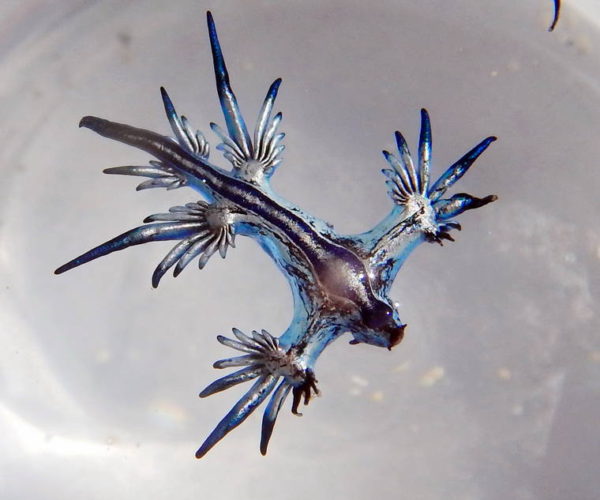Published in the Ocean Watch column, Honolulu Star-Advertiser © Susan Scott
August 24, 2019
Last week thousands of baby Portuguese men-of-war blew ashore on Oahu’s windward beaches, shipwrecked by the tradewinds. The men-of war were tiny, but their trailing tentacles worked just fine. Several small silvery fish also had washed up, still wrapped in men-of-war’s stinging blue threads.
As I bent to the nearly empty (of people) beach to admire the creatures, I spotted what turned out to be one of my all-time, best-ever beach finds. Soon my little dog, Pixel, and I were scouring the beach for a container to take my treasures home.
I had found, lying in the sand, four living, glowing nudibranchs called Glaucus.
 One of the four blue dragons, also called Glaucus atlanticus.
One of the four blue dragons, also called Glaucus atlanticus.
©2019 Susan Scott
That might seem like an awfully bland name for such a remarkable creature, but it works. In Greek mythology, Glaucus was a sea god who rescued sailors and fishers in storms. In addition, in ancient Greek, “glaukos” means glimmering, appropriate for the iridescent silver-and-blue nudibranch.
Although I prefer the ancient name, Glaucus, an English common name for this nudibranch is blue dragon. And although the species name is atlanticus, these mollusks live in the temperate and tropical waters of the Pacific and Indian oceans as well as the Atlantic. When a naturalist named the creature in 1777, he likely didn’t know its wide range.
The little nudibranch (a snail without a shell) grows to about 1-1/4 inches long, floating on the open ocean surface by means of an air bubble it holds in its stomach. The feathery appendages of the Glaucus act like blades, allowing the creature to paddle toward food, which is Portuguese men-of-war. When I placed my four lovely nudibranchs in a container of seawater, the rolled-up snails unfurled their bodies and swam to the two Portuguese men-of-war I had also collected.
Once a Glaucus eats a Portuguese man-of-war, the snail stores, intact, some of the tentacles’ stinging cells, recycling them for its own defense. You can see these stingers in the nudibranch’s blue “fingertips.”
Glaucus and other species of snails and jellyfish relatives, sometimes called the “wind drift community,” float around the ocean’s surface at the mercy of wind and currents. When those forces push them near our islands, blasts of strong wind can drive them to their deaths on our beaches.
A beached Glaucus is a rare find, mostly because the pea-size blue-and-white balls they form are easy to overlook. Drop a live one into a cup of seawater, though, and like a flower it will blossom into one the ocean’s most exquisite animals.
When I found those nudibranchs, I was first excited and then disappointed because the only one there to see the glorious Glaucus was Pixel, and she doesn’t get it. You readers do, though, a fact I know from your supportive emails, which keep me writing. Thank you, all, for writing and for allowing me to experience my marine adventures twice. They’re double the fun when I get to share them.